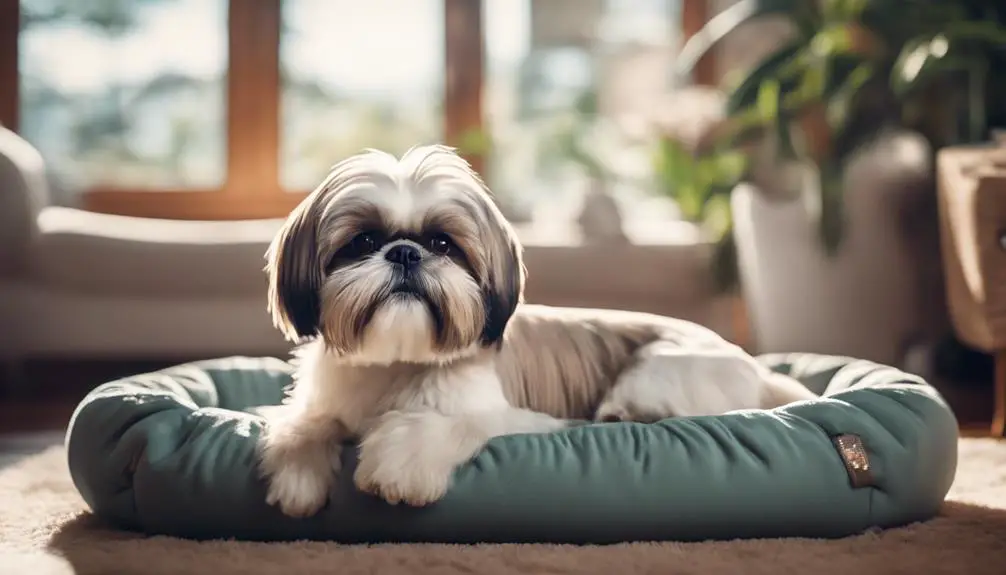If you're a Shih Tzu owner, you know how sensitive these charming little dogs can be to their surroundings. To keep them happy and healthy, it's essential you create an environment that meets their specific needs. From maintaining the right temperature and humidity indoors to ensuring safe, secure outdoor spaces for them to explore, every detail matters. But how do you tackle the challenge of balancing their need for social interaction with their equally strong need for quiet, stress-free zones? Let's explore some effective strategies that could transform your living space into a perfect haven for your Shih Tzu.
Ideal Indoor Living Spaces

Shih Tzus thrive in indoor environments that maintain a consistent, moderate temperature and are free from drafts. You'll want to keep your home within a temperature range of 68 to 78 degrees Fahrenheit. This breed is sensitive to extreme temperatures, so it's important to monitor your heating and cooling systems to avoid any sudden changes that might stress your pet.
In terms of humidity, aim for a level that's comfortable for humans—usually between 30% and 50%. High humidity can lead to respiratory problems in Shih Tzus, while too low can cause dry skin and irritation. Consider using a dehumidifier or humidifier to stabilize these levels depending on your local climate.
Flooring also plays a significant role in your Shih Tzu's comfort. Carpeting or rugs can provide a softer surface for their paws and help prevent slipping. However, you'll need to make sure that these are regularly cleaned to prevent the accumulation of dust and allergens, which can be harmful to their health.
Safe Outdoor Access Areas

While providing indoor comfort is essential, you'll also need to make sure that any outdoor access areas are safe and well-suited for your Shih Tzu.
First, evaluate the fencing in your yard. It should be secure enough to prevent your Shih Tzu from escaping and high enough to deter predators or other intruders. Look for gaps or weak points regularly, as these small dogs can squeeze through surprisingly small spaces.
Next, consider the surface of your outdoor area. Grass is ideal because it's gentle on their paws and helps to keep them cool. Avoid rough materials like gravel or concrete, which can be harsh on their delicate paws or contribute to overheating during warm weather. If you're using lawn treatments or pesticides, make certain they're pet-friendly to prevent accidental poisoning.
Also, make sure there's plenty of shade available. Shih Tzus can overheat quickly, so shaded areas provide necessary relief from the sun. Incorporate safe, non-toxic plants in these areas, as some common garden plants can be hazardous to pets.
Lastly, always provide clean, fresh water in a shaded spot to keep your Shih Tzu hydrated while they enjoy the outdoors. This setup not only keeps them safe but also enriches their environment, contributing to their overall well-being.
Climate Considerations for Comfort

Taking into account the specific climate needs of your Shih Tzu is crucial for maintaining their comfort and health. Shih Tzus are brachycephalic, meaning they've short noses and flat faces, which can complicate breathing, especially in extreme temperatures. Ideally, you'll want to keep your Shih Tzu in a moderately cool environment; temperatures between 68 to 72 degrees Fahrenheit (20 to 22 degrees Celsius) are ideal. This range helps prevent overheating and minimizes the risk of respiratory distress.
High humidity levels can also worsen breathing difficulties, so maintaining indoor humidity around 40-50% will make it easier for your Shih Tzu to breathe. Use a dehumidifier if you're in a particularly moist climate. On the flip side, very dry air isn't ideal either. Consider using a humidifier during dry winters to keep the air from becoming too harsh, which can irritate their respiratory tract and skin.
During hotter months, make sure your Shih Tzu has access to shaded areas and plenty of fresh, cool water. Avoid prolonged exposure to direct sunlight, and never leave your Shih Tzu in a parked car. Cooling mats and indoor air conditioning can greatly enhance their comfort. Dressing them in light, breathable clothing can also help regulate their body temperature without overheating.
Community and Social Interaction

Beyond climate control, ensuring your Shih Tzu engages in regular social interactions is essential for their emotional and psychological well-being. Shih Tzus, originally bred as companions, thrive on attention and interaction. They're not just pets but social beings who require a structured environment to socialize effectively.
You should introduce your Shih Tzu to a variety of environments where they can interact safely with other dogs and humans. This exposure helps mitigate behavioral issues such as anxiety and aggression, which can stem from isolation or inadequate socialization. Dog parks, pet-friendly events, and regular walks in busy areas are excellent for encouraging your Shih Tzu to engage with others.
Moreover, consider the dynamics of these interactions. Shih Tzus can be overwhelmed by larger, more boisterous breeds. Opt for playgroups or settings where your Shih Tzu can meet similar-sized or temperamentally compatible dogs. This consideration prevents negative experiences that could deter your dog from future socializing.
Lastly, balance these activities with periods of rest. While interaction is essential, overstimulation can lead to stress, affecting their overall health. Ensure your Shih Tzu has a steady routine that includes both socialization and downtime to prevent exhaustion.
Quiet Zones for Stress Reduction

You should create designated quiet zones in your home to help reduce stress and provide a sanctuary for your Shih Tzu. These areas are important in shielding your pet from excessive noise and activity, which can be overwhelming and lead to anxiety. Opt for a space that's seldom used during the day, such as a spare bedroom or a quiet corner in a study, where foot traffic is minimal.
Ensure the chosen area is well-equipped for comfort. Install thick, soft bedding and include items that carry your scent, like an old t-shirt or a soft blanket, as this can have a calming effect. The temperature should be kept consistent, avoiding fluctuations that could cause discomfort. Consider ambient noise control; soft, soothing music or a white noise machine can mask external sounds and further soothe your Shih Tzu.
Lighting also plays an important role in creating a relaxing environment. Utilize soft, warm lights or allow gentle natural light to filter in, keeping away harsh, bright lights that could disturb your dog's peace.
Regularly spend quiet time with your Shih Tzu in these zones, reinforcing them as safe, serene places free from the hustle and bustle of household activities.
Play Areas for Exercise

Designating specific play areas in your home guarantees your Shih Tzu gets ample exercise and remains active and healthy. Ideally, you'll choose an area with enough space for your pet to run, jump, and explore. This doesn't mean you need a huge room; a small, cleared area in your living room or bedroom can suffice as long as it's free of obstacles that could harm your dog.
When setting up this space, consider the flooring. Carpeting or rugs can provide a soft surface that's gentle on your Shih Tzu's joints, but make sure they're securely placed to prevent slips. Alternatively, interlocking foam mats are an excellent choice, offering comfort and easy maintenance.
Incorporate a variety of toys that encourage different types of physical activity. Interactive toys like small balls or puzzle feeders not only stimulate their body but also their mind. Make certain these toys are size-appropriate to avoid any choking hazards.
Additionally, rotating the toys regularly can maintain your Shih Tzu's interest and encourage frequent use of the play area. This strategy helps sustain their physical health and enhances their engagement with the environment, ensuring they're both physically and mentally stimulated.
Health and Safety Features

To guarantee your Shih Tzu's well-being, prioritize health and safety features in their living environment. First, consider flooring that prevents slips and falls; textured tiles or non-slip rugs can be important, especially for older dogs or those with joint issues.
It's also crucial to maintain a stable indoor temperature. Shih Tzus are brachycephalic (short-nosed) and can quickly overheat or develop respiratory problems in extreme temperatures. Aim for a thermostat setting around 68-72 degrees Fahrenheit.
Make sure all potential toxins, such as cleaning chemicals, plants poisonous to dogs, and small, swallowable objects, are securely out of reach. Since Shih Tzus can suffer from respiratory issues, it's important to ensure good air quality in your home. Use an air purifier to reduce allergens and dust that might aggravate breathing problems.
Regularly inspect your home for hazards like loose wires or sharp edges at Shih Tzu height. Install baby gates or similar barriers at stairs or risky areas to prevent falls.
Conclusion
To guarantee your Shih Tzu thrives, customize their environment carefully.
Indoors, maintain temperatures between 68-78°F and humidity around 30-50%. Use soft flooring and keep the space clean to protect their sensitive paws and respiratory system.
Outdoors, provide a secure, grassy area with ample shade and water. Incorporate quiet zones for stress relief and designated play areas for exercise.
Prioritizing these aspects will greatly enhance your Shih Tzu's quality of life and well-being.


